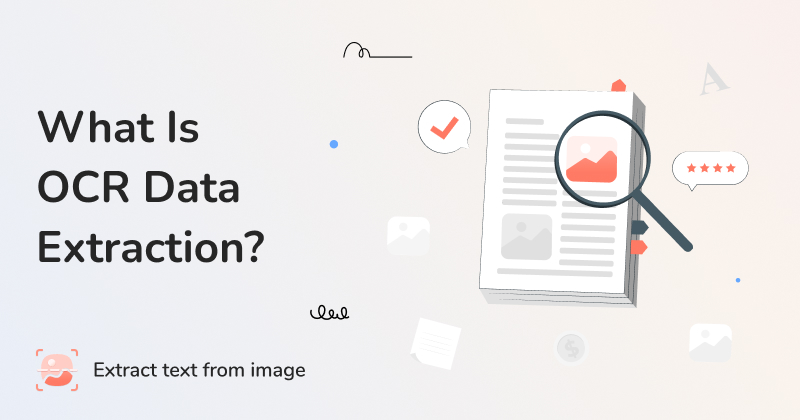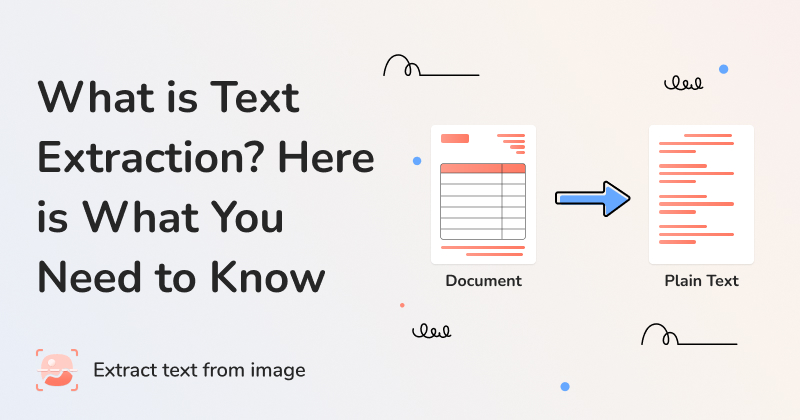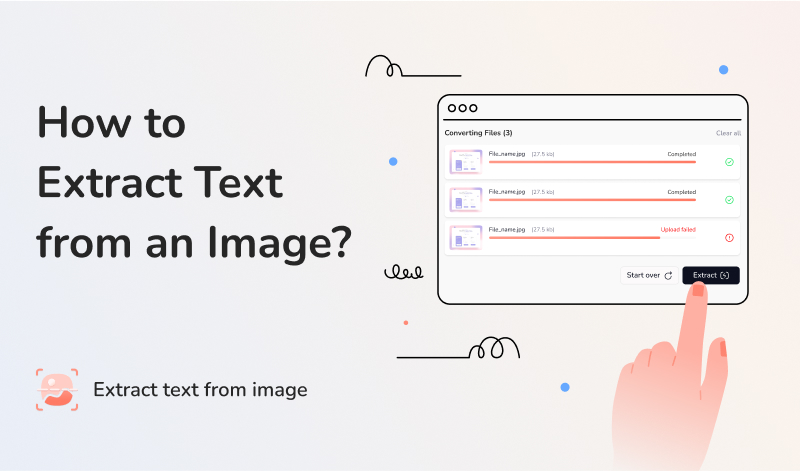OCR (Optical Character Recognition) is a technology that detects scanned or printed documents to make them machine-readable.
Data extraction is a process in which information is gathered from various sources, such as blog posts and social media content.
Combining these two gives you OCR data extraction, a procedure that most modern-day businesses and companies employ to streamline their workflow and uplift productivity.
Extracting data with OCR ensures the least human intervention possible in the data entry process, eliminating any errors associated with manual labor.
Plus, obtaining data in structured form allows organizations to make better decisions, making them more relevant to the industry.
Today’s topic will discuss everything about OCR data extraction: what it is and how it works. So, let’s get started.
How Does OCR Data Extraction Work?
To learn the capabilities of OCR, it’s important to understand the process. Here's a simplified breakdown of how this technology works:
Image Capture: First, we seize an image of the document containing text. A scanner, camera, or even a smartphone can be used to do this.
Preprocessing: Tools and software embedded with OCR capabilities will process the captured image to increase its quality. This will include reduction of noise, improving contrast, and adjusting brightness so that textual data becomes more visible.
Character Recognition: The OCR tool analyzes the image by leveraging its Machine Learning algorithms to find letters, numbers, and symbols. Then, it compares the detected character patterns with the database it has at the backend.
Post Processing: After the text is read, it is converted into digital format. The text here can be stored, searched, and edited as you need to.
Verification: Lastly, the extracted text is verified for correctness. Advanced OCR systems can automatically correct common grammatical and punctuation errors in data extraction, guaranteeing extremely high precision.
All these 5 steps form the core of the data extraction process with OCR. However, many OCR solutions are convoluted with other systems like Translators, Transcribers, etc. So, the mentioned stages may occur in a different order for various types of systems.
Why is OCR Data Extraction Important for Businesses?
OCR helps with making information easily available for businesses, making them apt to deal with critical scenarios.
However, the most important consideration for choosing OCR data extraction over manual workers is cost. On average, a data entry specialist will charge you around $19.47 per hour. Compare this with quality OCR software that you can get at the same price for a month.
Considering the speed, accuracy, and cost-effectiveness of OCR tools and software, hiring and maintaining manual workers for data extraction isn’t viable anymore.
Thus, OCR data extraction technology is very valuable for small to large-scale organizations to efficiently conduct their daily tasks and operations.
Pro Tip: Consider taking help from a free online OCR solution like Extracttextfromimage.com. This tool will maintain high precision in extracting various types of data while providing batch-processing capabilities. |
Real-world Examples of OCR Applications
In real life, organizations and large-scale businesses often work closely with ECM (Enterprise Content Management) systems. This allows the data extracted to be fed directly to the databases of the company with the least human intervention possible.
The fact that OCR technology can integrate with a wide range of applications and systems makes it scalable. Thus, despite its high initial installation cost, companies are eager to implement OCR with ECM systems as it helps them develop sustainable frameworks.
According to a survey by Mordor Intelligence, 46% of employees spend their time on inefficient paper-related tasks, something that can be easily done with OCR and ECM. Hence, it is preferable to utilize OCR data extraction to boost productivity.
OCR has permeated various sectors of life, revolutionizing how data is managed and utilized. Some of the examples are given below:
Finance
In the finance industry, OCR is used to expedite the processing of invoices, checks, and receipts. It enables quick text extraction from financial documents, improving transaction accuracy and customer service efficiency.
Healthcare
OCR technology assists healthcare providers by digitizing patient records and medical forms. This not only enhances record-keeping accuracy but also facilitates quicker information retrieval during critical scenarios.
Education
Educational institutions leverage OCR to convert physical books and notes into digital format. This aids in easier access to learning materials and promotes digital learning environments.
Retail
Retailers utilize OCR for inventory management by extracting product details from barcodes and labels. This streamlines supply chain operations and helps maintain accurate stock levels.
OCR Technology Trends
The evolution of OCR technology continues to pave new paths for innovation and efficiency. Understanding the current circumstances will allow you to look for future patterns and digitize the businesses accordingly.
Current Advancements
Recent advancements in OCR technology include improved recognition algorithms that handle complex characters and fonts with greater precision.
This development augments the capability of the OCR systems to extract text from various styles of handwriting, and images with bad contrast or quality.
Future Developments
The future of OCR looks promising with developments in newer natural language processing (NLP) algorithms like the Bayesian Network.
This means that in the days to come, we will be able to extract data with OCR more quickly, cheaply, and efficiently. No matter the circumstances, the tools embedded with the said technology will ensure that humans never go back to doing repetitive, dull tasks by hand ever again.
Implementing OCR in Your Business
Integrating OCR into your business operations can be a straightforward process with the right approach. However, for a successful integration of OCR, you must be aware of the following things.
Practical Tips
Start by identifying the areas in your business that involve substantial data entry tasks. Consider adopting OCR solutions that align with your industry-specific needs, such as Extract Text from Image.
Considerations
Evaluate the compatibility of OCR tools with your existing systems and ensure they meet your data security standards. It's also crucial to provide training for your team to maximize the benefits of OCR technology and not run into activity overlaps.
Conclusion
OCR data extraction is a rapidly evolving technology that is changing how we work with information. Its benefits range from saving manual labor to increasing the accuracy of data entered into systems.
As a business owner, data analyst, or tech enthusiast looking to maximize the presented information, OCR technology is the answer.
Use free online tools like Extract Text from Image to improve your data management practices and streamline your workflow for maximum impact.





